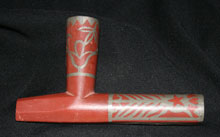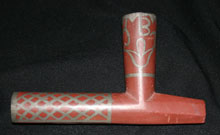Calumet Pipe

A calumet, from the French word chalumet, meaning reed or flute, is a profoundly sacred object to many Native American tribes. These pipes were used in a variety of ceremonies including peace and war, but more often for peace giving them the "peace pipe" name. The distinctive "t-shape" of this pipe dates it to c1850 and the style and shape of the lead inlay suggests a Plains tribe origin.
The calumet pipe bowl is made from red catlinite or pipestone. Catlinite is an iron-rich, reddish, soft quartzite slate typically excavated from below groundwater level, as the stone erodes rapidly when exposed to the weather and outside air. Red pipestone was used by the Eastern Tribes, Western and Great Basin Tribes, and the Plains Tribes, with sources of the stone in Tennessee (South Central), Minnesota (Pipestone), and Utah (Delta, Uinta). Sacred pipestone comes from Pipestone, Minnesota. The quarry itself is located just north of the town at the Pipestone National Monument. Today only people of Native American ancestry are allowed to quarry the pipestone from this quarry. The pipestone or catlinite from this quarry is softer than any other catlinite.

The decoration on this distinctive pipe bowl is made by flooding carvings in the stone with molten lead. These designs contain a flower, a turtle as well as several curvilinear designs suggesting plant life as well as a stylized snake on the underside of the bowl where it meets the stem of the pipe.

